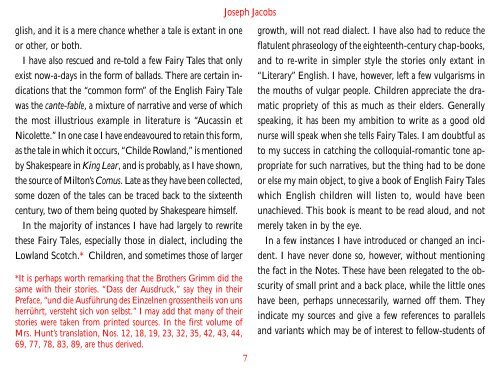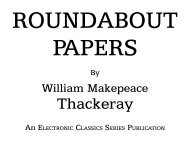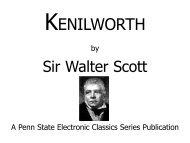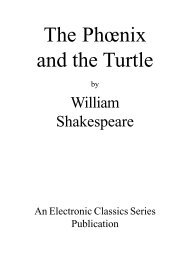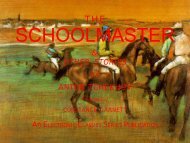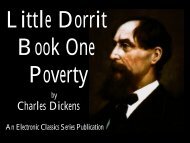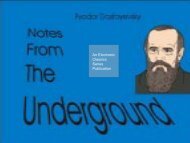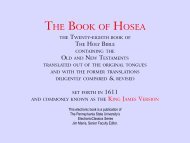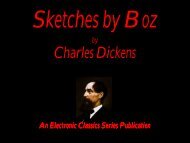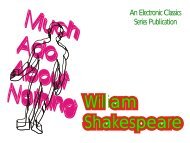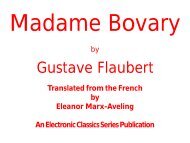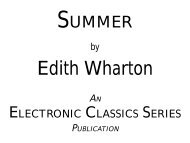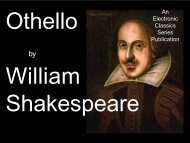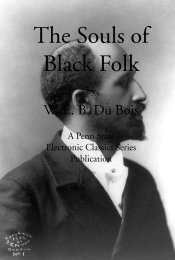<strong>English</strong> <strong>Fairy</strong> <strong>Tales</strong>common fund of nursery literature to all classes of the <strong>English</strong>people, and, in any case, it can do no harm to add tothe innocent gaiety of the nation.A word or two as to our title seems necessary. We havecalled our stories <strong>Fairy</strong> <strong>Tales</strong> though few of them speak offairies.* The same remark applies to the collection of theBrothers Grimm and to all the other European collections,which contain exactly the same classes of tales as ours. Yetour stories are what the little ones mean when they clamourfor “<strong>Fairy</strong> <strong>Tales</strong>,” and this is the only name which they giveto them. One cannot imagine a child saying, “Tell us a folktale,nurse,” or “Another nursery tale, please, grandma.” Asour book is intended for the little ones, we have indicated itscontents by the name they use. The words “<strong>Fairy</strong> <strong>Tales</strong>” mustaccordingly be taken to include tales in which occurs something“fairy,” something extraordinary—fairies, giants,dwarfs, speaking animals. It must be taken also to cover talesin which what is extraordinary is the stupidity of some ofthe actors. Many of the tales in this volume, as in similar*For some recent views on fairies and tales about fairies, seeNotes.6collections for other European countries, are what the folkloristscall Drolls. They serve to justify the title of MerrieEngland, which used to be given to this country of ours, andindicate unsuspected capacity for fun and humour amongthe unlettered classes. The story of Tom Tit Tot, which opensour collection, is unequalled among all other folk-tales I amacquainted with, for its combined sense of humour and dramaticpower.The first adjective of our title also needs a similar extensionof its meaning. I have acted on Molière’s principle, andhave taken what was good wherever I could find it. Thus, acouple of these stories have been found among descendantsof <strong>English</strong> immigrants in America; a couple of others I tell asI heard them myself in my youth in Australia. One of thebest was taken down from the mouth of an <strong>English</strong> Gipsy. Ihave also included some stories that have only been found inLowland Scotch. I have felt justified in doing this, as of thetwenty-one folk-tales contained in Chambers’ “PopularRhymes of Scotland,” no less than sixteen are also to be foundin an <strong>English</strong> form. With the Folk-tale as with the Ballad,Lowland Scotch may be regarded as simply a dialect of En-
Joseph Jacobsglish, and it is a mere chance whether a tale is extant in oneor other, or both.I have also rescued and re-told a few <strong>Fairy</strong> <strong>Tales</strong> that onlyexist now-a-days in the form of ballads. There are certain indicationsthat the “common form” of the <strong>English</strong> <strong>Fairy</strong> Talewas the cante-fable, a mixture of narrative and verse of whichthe most illustrious example in literature is “Aucassin etNicolette.” In one case I have endeavoured to retain this form,as the tale in which it occurs, “Childe Rowland,” is mentionedby Shakespeare in King Lear, and is probably, as I have shown,the source of Milton’s Comus. Late as they have been collected,some dozen of the tales can be traced back to the sixteenthcentury, two of them being quoted by Shakespeare himself.In the majority of instances I have had largely to rewritethese <strong>Fairy</strong> <strong>Tales</strong>, especially those in dialect, including theLowland Scotch.* Children, and sometimes those of larger*It is perhaps worth remarking that the Brothers Grimm did thesame with their stories. “Dass der Ausdruck,” say they in theirPreface, “und die Ausführung des Einzelnen grossentheils von unsherrührt, versteht sich von selbst.” I may add that many of theirstories were taken from printed sources. In the first volume ofMrs. Hunt’s translation, Nos. 12, 18, 19, 23, 32, 35, 42, 43, 44,69, 77, 78, 83, 89, are thus derived.7growth, will not read dialect. I have also had to reduce theflatulent phraseology of the eighteenth-century chap-books,and to re-write in simpler style the stories only extant in“Literary” <strong>English</strong>. I have, however, left a few vulgarisms inthe mouths of vulgar people. Children appreciate the dramaticpropriety of this as much as their elders. Generallyspeaking, it has been my ambition to write as a good oldnurse will speak when she tells <strong>Fairy</strong> <strong>Tales</strong>. I am doubtful asto my success in catching the colloquial-romantic tone appropriatefor such narratives, but the thing had to be doneor else my main object, to give a book of <strong>English</strong> <strong>Fairy</strong> <strong>Tales</strong>which <strong>English</strong> children will listen to, would have beenunachieved. This book is meant to be read aloud, and notmerely taken in by the eye.In a few instances I have introduced or changed an incident.I have never done so, however, without mentioningthe fact in the Notes. These have been relegated to the obscurityof small print and a back place, while the little oneshave been, perhaps unnecessarily, warned off them. Theyindicate my sources and give a few references to parallelsand variants which may be of interest to fellow-students of
- Page 1 and 2: ENGLISHFAIRY TALESCOLLECTED BYJOSEP
- Page 3 and 4: ContentsPreface....................
- Page 5: ENGLISHFAIRY TALESCOLLECTED BYJOSEP
- Page 9 and 10: Joseph JacobsTOMTIT TOT“I’ll ha
- Page 11 and 12: Joseph Jacobs“Well,” says she,
- Page 13 and 14: Joseph JacobsWell, when the girl he
- Page 15 and 16: Joseph Jacobscame to a woman’s co
- Page 17 and 18: Joseph Jacobsthe loss. She said to
- Page 19 and 20: Joseph JacobsIn ran father and son,
- Page 21 and 22: Joseph Jacobsfire; the fire began t
- Page 23 and 24: Joseph Jacobs“I started to go ups
- Page 25 and 26: Joseph Jacobsthe boys followed him
- Page 27 and 28: Joseph Jacobstakes up the vegetable
- Page 29 and 30: Joseph Jacobsdead asleep upon a ben
- Page 31 and 32: Joseph Jacobshe went off as fast as
- Page 33 and 34: Joseph Jacobshair were pearls and p
- Page 35 and 36: Joseph JacobsThe faster you’d eat
- Page 37 and 38: Joseph JacobsNext day they said to
- Page 39 and 40: Joseph JacobsTEENY-TINYawakened by
- Page 41 and 42: Joseph JacobsBack goes Jack home, a
- Page 43 and 44: Joseph Jacobspassing the ogre he to
- Page 45 and 46: Joseph JacobsJack ran as fast as he
- Page 47 and 48: Joseph JacobsWell, he huffed, and h
- Page 49 and 50: Joseph JacobsOne day the master was
- Page 51 and 52: Joseph Jacobsweeps, and so I hop;
- Page 53 and 54: Joseph Jacobsfor you to go, and God
- Page 55 and 56: Joseph JacobsThe gentleman now make
- Page 57 and 58:
Joseph Jacobshim in his other waist
- Page 59 and 60:
Joseph Jacobsgoing on with what the
- Page 61 and 62:
Joseph Jacobsabout the little porri
- Page 63 and 64:
Joseph Jacobsthe little old Woman j
- Page 65 and 66:
Joseph Jacobsfountain and fell fast
- Page 67 and 68:
Joseph Jacobssuch great numbers tha
- Page 69 and 70:
Joseph Jacobsbrought it under his i
- Page 71 and 72:
Joseph JacobsThen, coming to the mi
- Page 73 and 74:
Joseph JacobsHENNY-P-PENNYSo they w
- Page 75 and 76:
Joseph Jacobshim, he called out to
- Page 77 and 78:
Joseph Jacobsshe said the spell tha
- Page 79 and 80:
Joseph JacobsThe hall was furnished
- Page 81 and 82:
Joseph JacobsWho have you there wif
- Page 83 and 84:
Joseph JacobsBut Molly never said a
- Page 85 and 86:
Joseph Jacobsbut it was not a good
- Page 87 and 88:
Joseph Jacobs“Snouk but and snouk
- Page 89 and 90:
Joseph JacobsTHE HISTORORY Y OF TOM
- Page 91 and 92:
Joseph Jacobsone mouthful. While th
- Page 93 and 94:
Joseph Jacobsbut at last poor Tom f
- Page 95 and 96:
Joseph Jacobsging a beautiful young
- Page 97 and 98:
Joseph JacobsLAZY JACKCKold woman;
- Page 99 and 100:
Joseph JacobsJOHNNY-CAKEOn went Joh
- Page 101 and 102:
Joseph JacobsEARL MAR’S DAUGHTERa
- Page 103 and 104:
Joseph Jacobsflew till they swooped
- Page 105 and 106:
Joseph JacobsWhen he got him there,
- Page 107 and 108:
Joseph Jacobsyou will like a sousin
- Page 109 and 110:
Joseph Jacobsbe a man! Well, I will
- Page 111 and 112:
Joseph Jacobspresent that the king
- Page 113 and 114:
Joseph JacobsTHE STRANGE VISITORORt
- Page 115 and 116:
Joseph JacobsTHE LAIDLAIDLY WORMfor
- Page 117 and 118:
Joseph JacobsAs the ship came near,
- Page 119 and 120:
Joseph Jacobscow may give me milk,
- Page 121 and 122:
Joseph Jacobsafter having been brou
- Page 123 and 124:
Joseph JacobsTHE MAGPGPIE’S NESTO
- Page 125 and 126:
Joseph Jacobsto eat, so watched the
- Page 127 and 128:
Joseph Jacobsfound Kate and the you
- Page 129 and 130:
Joseph JacobsTHE ASS, THE TABLE, AN
- Page 131 and 132:
Joseph Jacobswith it to the inn, an
- Page 133 and 134:
Joseph Jacobsof fire, and off they
- Page 135 and 136:
Joseph Jacobstom of the sieve with
- Page 137 and 138:
Joseph JacobsMASTER OF ALL MASTERS
- Page 139 and 140:
Joseph Jacobsever they require, tha
- Page 141 and 142:
Joseph Jacobswho she was.“I am,
- Page 143 and 144:
Joseph JacobsII. THE THREE SILLIES.
- Page 145 and 146:
Joseph JacobsVI. MR. VINEGAR.VII. N
- Page 147 and 148:
Joseph JacobsXI. CAP O’ RUSHES.XI
- Page 149 and 150:
Joseph JacobsXVI. TATTY MOUSE AND T
- Page 151 and 152:
Joseph Jacobscluding the mice, is a
- Page 153 and 154:
Joseph JacobsXX. HENNY-P-PENNYENNY.
- Page 155 and 156:
Joseph Jacobsand adapted it to the
- Page 157 and 158:
Joseph Jacobsthings may have happen
- Page 159 and 160:
Joseph JacobsXXII. MOLLY WHUPPIE.So
- Page 161 and 162:
Joseph Jacobsthe Germans, and simil
- Page 163 and 164:
Joseph Jacobsof a domestic Providen
- Page 165 and 166:
Joseph JacobsXXXIV. . CAT AND MOUSE
- Page 167 and 168:
Joseph JacobsXXXIX. ASS, TABLE AND
- Page 169:
Joseph JacobsXLIII. THE THREE HEADS


